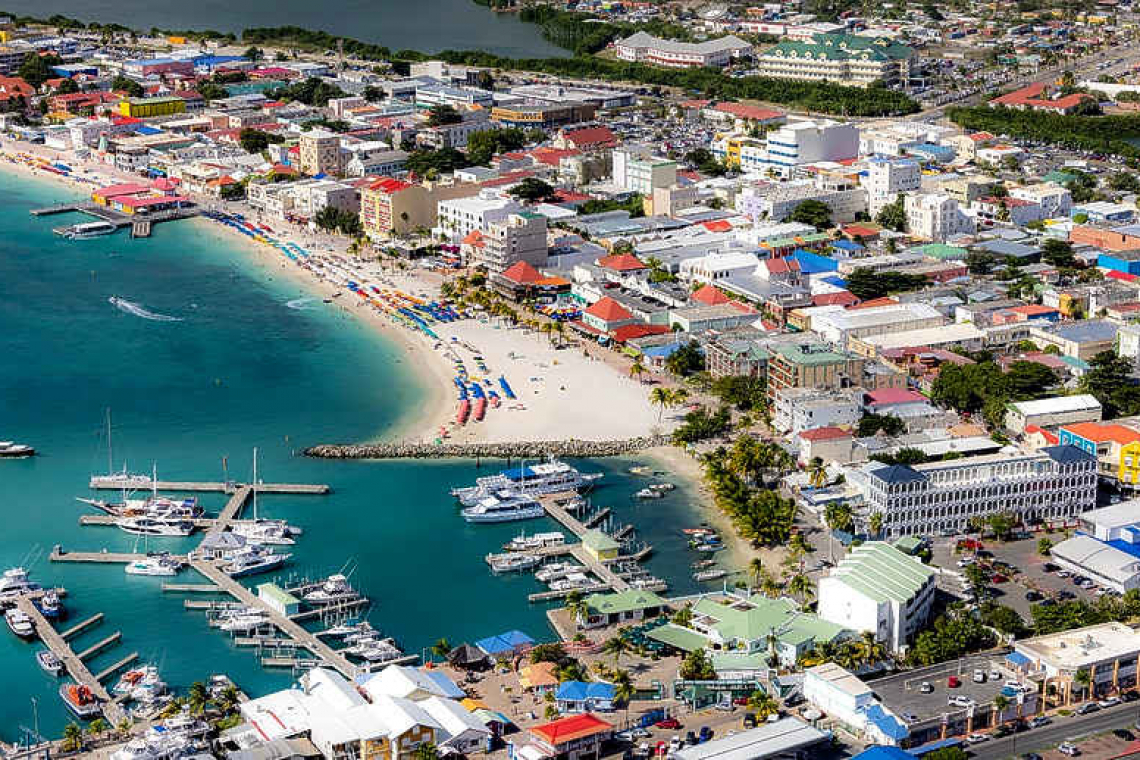An aerial view of Philipsburg. (Ellinger Paul photo)
PHILIPSBURG--Creating a floating farm and a “Fun Pond” attraction in Great Salt Pond and an Orton botanical garden and aquarium in Simpson Bay Lagoon are proposals that businessman Louis Engel believes government can explore in an effort to generate substantial income, attract more tourists and help St. Maarten become more self-sufficient.
Engel outlined the details of his proposals to Members of Parliament (MPs) during a meeting of Parliament’s Committee of Tourism, Economic Affairs, Transport and Telecommunication (TEATT) on Tuesday. His proposal for the floating farm and fun pond are proposals that would be given to government to explore free of cost under the condition that Engel will be the project supervisor, while the proposal for the botanical garden and aquarium are for sale. Engel would like to manage the latter projects.
Engel said he had developed the proposals. He told The Daily Herald after Tuesday’s meeting that the sale price of the two tourist attraction projects is still to be determined and depends on the extent of his involvement.
“For example, if I produce the project feasibility report and the project assessment report on my account, then this will have to be taken into account when establishing the cost of sale of the project concepts. The time and effort it takes to gather the required information also plays a role in establishing the sale price. Other expenses may also be incurred from the gathering and preparing of relevant information, such as paper and ink used for preparation of documents,” he said.
He has requested a meeting with the Council of Ministers to make a presentation on the proposals.

A concept of the Soualiga Fun Pond.
“Should the Council of Ministers find themselves in these projects and request of me to provide the project feasibility and assessment reports, then I will proceed with the development of these projects. Government will not be responsible for any expenses related to the preparation of the reports. All that is required is a commitment by the government to pursue these projects once the reports are positive,” Engel told this newspaper.
Soualiga Feed Us Floating Farm
Engel’s idea for a floating farm is to create a hurricane-resistant structure in Great Salt Pond where vegetation, fish and/or animal farming can be done to help supply the population with fish, meat and vegetables, create an income for government and help St. Maarten become more self-sufficient.
The concept of a floating farm was first introduced in the Netherlands and is now being done in other countries. Engel said the Salt Pond has been unproductive and it can be used, particularly given that there are challenges with land for farming.
The Floating Farm, he said, is built out of steel and anchored in the water. He stressed that this is a project that government should run so that the benefits flow back to the people. Government, he said, can determine what types of crops it wants grown in the floating farm as well as what types of animals it wants reared. He said it can start with fast-growing crops and animals for a quick turnover.
The farms can be run on solar power or wind energy and can be equipped with a rainwater collection system. The system maximises production quantity with less water consumption and will yield eight times more produce with four times less water. Engel said also that the waste from the animals can be used as manure for the crops and the leftover bio-waste from vendors can be used to feed the animals.
He suggested that government explore APS Pension Fund Administrator or the Dutch government for financing for the project.
The developer of the floating farm began with 40 cows producing milk and yogurt and it became highly successful. One in Barcelona, Spain, started with 17 employees and generated US $1.6 million. A floating farm will take 8-12 months to set up. Engel stressed that the idea is for government to take on the project. “It should not be in private hands, because you don’t see the benefits for the money that comes in,” he said.
Soualiga Fun Pond Attraction
The Soualiga Fun Pond Attraction is proposed to be an eco-tourism attraction set up in Great Salt Pond. The intention is to offer simulated salt mining and production with life-size robotic figures with movement and sounds. Visitors to the attraction will be able to take train ride tours and boat ride tours at the salt mining and production site.
There can also be fishing sports – catch and release attraction, and future attractions can be added such as rowboat and pedal boat rides. The attractions can be opened day and night and can bring in revenue for government while expanding the country’s tourist attractions.
“The Salt Pond was a natural resource commodity production plant that today has the potential to generate livelihood once again,” he said.
Potential revenue streams will include entrance ticket sales, food and beverages sales, souvenirs sales, sports fishing, and rowboat and pedal boat rides. He suggested that children under 3 be admitted for free and proposed cost for the rides range from US $12.50 to $25 depending on the age of the visitor and whether the ride is in the day or night. He estimated that the project can rake in an annual gross income of $7 million per year. He said the investment cost is not yet known.
Engel told MPs that the intention is for this project to also be owned by government and suggested that the Dutch government be approached for financing.
Soualiga Orton Botanical Garden and Caribbean Sea Life Aquarium
The proposal for the Soualiga Orton Botanical Garden and Caribbean Sea Life Aquarium is for two attractions to be set up in Simpson Bay Lagoon: a cacti variety botanical garden which is proposed to include roaming local animals as well as an aquarium.
Engel said the intention is for a submerged tunnel to be built in the lagoon where persons can enter and see fish in their natural habitat. An area will be enclosed in the lagoon for the fish to remain in the area of the aquarium, but still be in their natural habitat.
He said many varieties of cactus grow naturally in the Caribbean, but for the botanical garden, cactus from any part of the world can be planted for people to explore. Persons will be able to enter the botanical garden and interact with the animals. Engel said he had been assured that the project is feasible and can be constructed to withstand powerful hurricane winds.
He proposed that the project be based at “Chicken Island” in the Lagoon. He proposed entrance fees of $12.50 to $40 depending on the age of the visitor and whether the visit is during the day or night, and estimated that the project has the capacity to generate an income of more than $11 million annually.







